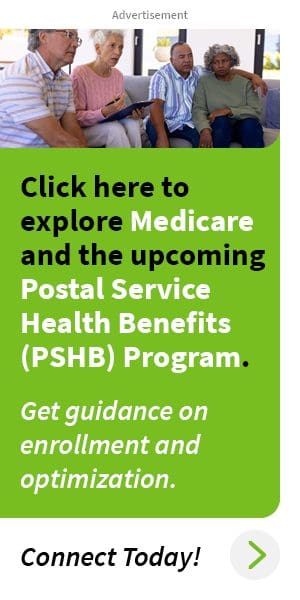Key Takeaways
-
The 2025 Postal Service Health Benefits (PSHB) Program introduces sweeping changes to federal employee healthcare, reshaping coverage for USPS workers and retirees.
-
Knowing how the new system integrates with Medicare and how it affects costs will help you navigate the transition smoothly.
A Game-Changer for USPS Employees and Retirees
Big changes are coming to your health benefits. If you’re part of the USPS workforce or a retiree, the 2025 launch of the Postal Service Health Benefits (PSHB) Program will replace the Federal Employees Health Benefits (FEHB) Program for postal employees and their families. These updates are designed to provide healthcare options better suited to your unique needs while addressing costs and efficiency.
Let’s break down how this program is set to reshape federal employee healthcare and what it means for you.
Why the Switch to PSHB?
The move to PSHB is about making healthcare coverage more effective and sustainable. Here’s what’s driving the change:
-
Targeted Benefits: Unlike FEHB, which serves all federal workers, PSHB is tailored exclusively for USPS employees and retirees.
-
Financial Stability: Rising healthcare costs have strained USPS finances. PSHB aims to reduce costs while maintaining robust benefits.
-
Medicare Integration: For retirees, closer coordination with Medicare Part B ensures streamlined and comprehensive coverage.
Key Dates You Can’t Miss
To stay ahead of the changes, here are the key dates to keep in mind:
-
Open Season: November 11 to December 9, 2024. This is your window to review and select your PSHB plan.
-
Effective Date: January 1, 2025. Your PSHB plan will officially replace your FEHB coverage.
Mark these dates on your calendar and prepare early to ensure a seamless transition.
How PSHB Differs From FEHB
Exclusive Plans for USPS
PSHB plans are specifically designed for USPS employees and retirees, offering:
-
Relevant Benefits: Coverage that reflects occupational health risks and challenges unique to postal workers.
-
Enhanced Access: Plans are structured to meet the needs of employees in underserved or remote areas.
Medicare Coordination
For Medicare-eligible retirees, the PSHB Program integrates with Medicare Part B to provide:
-
Comprehensive Coverage: Medicare covers primary services, while PSHB handles supplemental benefits.
-
Lower Costs: Integration reduces redundancies and helps control out-of-pocket expenses.
Who Needs to Act?
Current USPS Employees
If you’re actively working, these changes might seem distant, but understanding them now will help you prepare for the future. Key actions include:
-
Stay Updated: Follow USPS updates to stay informed about how PSHB will affect you.
-
Plan Ahead: Learn about Medicare Part B requirements so you’re ready when retirement comes.
USPS Retirees
For retirees, the transition to PSHB is automatic, but there are important steps to take:
-
Medicare Enrollment: Retirees eligible for Medicare Part B must enroll to maintain PSHB coverage. The 2025 standard premium is $185 per month, with a $257 annual deductible.
-
Check Your Exemptions: If you retired on or before January 1, 2025, and aren’t enrolled in Medicare Part B, you’re exempt from this requirement.
Medicare Part B: What You Need to Know
Medicare Part B works alongside PSHB to provide comprehensive coverage. Here’s how it benefits you:
-
Primary Coverage Role: Medicare handles outpatient services, preventive care, and doctor visits, while PSHB covers additional expenses like copayments.
-
Financial Predictability: Though Medicare Part B has premiums and deductibles, it minimizes the risk of significant out-of-pocket costs.
Benefits of the New PSHB Program
Preventive Healthcare
PSHB plans prioritize keeping you healthy. Comprehensive preventive services, including routine check-ups, vaccinations, and screenings, are fully covered to help detect issues early and reduce long-term healthcare costs.
Expanded Mental Health Support
Recognizing the growing importance of mental health, PSHB offers extensive counseling and therapy services. These benefits ensure mental health is treated as a priority alongside physical health.
Prescription Drug Coverage
Through integration with Medicare Part D, PSHB plans include a $2,000 annual cap on out-of-pocket prescription drug costs. This limit helps retirees manage chronic conditions and high medication costs more effectively.
What You Need to Do During Open Season
Open Season is your opportunity to take control of your healthcare coverage. Follow these steps to make informed choices:
-
Review Your Current Plan: Assess your current FEHB plan and identify any gaps or areas for improvement.
-
Compare PSHB Options: Examine premiums, deductibles, and benefits to find the best match for your healthcare needs.
-
Prepare for Medicare Enrollment: If you’re nearing 65, understand the process for enrolling in Medicare Part B.
-
Seek Assistance: Reach out to USPS HR or the Office of Personnel Management (OPM) for guidance.
Common Concerns About the Transition
Will My Coverage Be Interrupted?
No. The transition from FEHB to PSHB is designed to be seamless. Automatic enrollment ensures no gaps in your healthcare coverage.
Can I Keep My Current Doctors?
Most PSHB plans have extensive provider networks, but it’s always a good idea to verify that your preferred doctors and specialists are included.
What Happens If I Don’t Enroll in Medicare Part B?
If you’re Medicare-eligible and don’t enroll in Part B, you may lose your PSHB coverage. It’s crucial to understand and meet this requirement.
How to Prepare for a Smooth Transition
Here are practical steps to ensure a hassle-free shift to PSHB:
-
Stay Organized: Keep all important documents, including Medicare enrollment details and current healthcare plan information, in one place.
-
Set Alerts: Use reminders to keep track of deadlines for Open Season and Medicare enrollment.
-
Communicate With Dependents: Make sure your family members understand how the changes might affect their coverage.
Why This Program Is a Step Forward
While change can feel overwhelming, the PSHB Program offers significant advantages:
-
Tailored Coverage: Plans are designed specifically for USPS employees and retirees, ensuring more relevant benefits.
-
Cost Efficiency: The integration with Medicare helps reduce redundancies and offers more predictable healthcare costs.
-
Expanded Services: Enhanced preventive care, mental health support, and prescription drug coverage reflect modern healthcare priorities.
Taking Charge of Your Healthcare Future
The 2025 rollout of the Postal Service Health Benefits Program is an opportunity to improve how you manage your healthcare. By understanding the new program, preparing during Open Season, and addressing Medicare requirements, you can ensure smooth and effective coverage. This transition is more than a change; it’s a chance to align your benefits with your unique needs for years to come.











